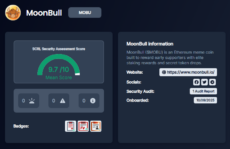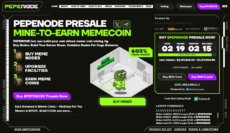With a good audit score and a structured presale, MoonBull (MOBU) looks promising. Still, anonymous leadership and aggressive mark...
With a good audit score and a structured presale, MoonBull (MOBU) looks promising. Still, anonymous leadership and aggressive marketing call for caution.
This meme token has real mechanics, including a 23-stage presale, reflections, burns, staking, and governance. At first glance, it looks like a decent system designed for everyday traders. But the question on everyone’s mind is simple: is MoonBull actually legit, or just another crypto scam?
In this post, we will take a close look at the project’s whitepaper, tokenomics, roadmap, and community features. This info should help you understand the token better and decide if it is worth your attention, or if it’s better to sit this one out.
Is MoonBull Legit? Key Takeaways
- MoonBull markets itself as a meme coin with added mechanics like staking, governance, and reflection, which is a mix of hype and tokenomics.
- The supply allocation and presale breakdown are clearly defined, with 50% for presale and 20% for staking rewards. Success depends heavily on post-listing demand.
- The SRCL audit scored highly with two minor unresolved issues. Liquidity is locked for 24 months, and ownership will be renounced.
- Team identities remain undisclosed, which adds uncertainty despite having a small allocation and a long lock-up.
- Referral bonuses, giveaways, and high-staking APYs drive attention but also carry typical “hype project” risks.
Is MoonBull Legit or a Scam? What to Consider
To determine if the project is legit or a scam, we need to take a closer look at the tokenomics, roadmap, its goals and technology, and much more.
Project’s Tokenomics
MoonBull outlines a very specific token model on its site, with a total supply of 73.2 billion MOBU. Allocations include 50% for presale, 10% for liquidity (locked two years), 20% for staking rewards, 11% for referrals, 5% for community incentives and burns, and small amounts for influencers and the team (2% each).

Moonbull tokenomics table. Source: Moonbull
Analysis:
- The breakdown is clear and gives a sense of transparency, which is a green flag.
- The staking rewards (20% pool) and allocations for token burn and reflections are nice in theory, but the sustainability depends on actual trading volume and demand.
- A large portion (50%) is in presale. This is not uncommon for new cryptocurrencies, but it raises the question: how many will hold vs. sell on listing? Big unlocks could put pressure.
- The model of reflections and burns tries to reward holding. Still, those systems often depend on ongoing trading activity. If trading slows down, the mechanics might not deliver as promised.
The bottom line is that the tokenomics are better defined than many meme tokens. But “defined” doesn’t equal “safe” and is definitely not guaranteed to work. The key is execution and volume.
Utility and Functionality
The token is built on Ethereum (ERC-20) for broad compatibility. MoonBull has a staking system offering a fixed 95% APY for holders (from a 14.64 billion MOBU pool) once Stage 10 hits.
It also has a referral system. If someone uses your code, you get 15% of their purchase amount in tokens, and they get a +15% bonus in return.

Moonbull referrals page. Source: Moonbull
Finally, there is the governance mechanism. Starting from stage 12, holders get one vote per token for decisions like burns or campaign strategies.
Analysis:
These features go beyond pure “buy and hope for price rise”. They provide functionality (staking, referrals, and governance). Utility is present on paper and looks stronger than many meme coins on the market.
Still, 95% APY is extremely high. This kind of yield will attract a lot of speculative entrants, but it may also become unsustainable or even lead to heavy dilution if it’s not matched by strong token demand.
Decentralized governance sounds great, but its value will depend on how meaningful the votes are and how the team handles the outcomes. It also hinges on sustained community engagement, which isn’t a certainty.
Finally, referrals can help growth, but heavy incentives may attract low-quality players who come for the rewards and not the project’s long-term value.
Security and Audits
According to the project’s official website and press mentions, MoonBull claims smart contracts built with OpenZeppelin standards, audited by “leading blockchain security firms”. It also mentions liquidity locked for 24 months and ownership renounced at launch.
The audit the website links to is by SCRL.io, with a security assessment score of 9.7/10. The audit was published in September 2025 and lists two unresolved findings at the moment.

Moonbull SCRL.io audit. Source: SCRL.io
Analysis: A high audit score is good, but it doesn’t eliminate the risk of a scam or project failure. Even a well-audited contract can face issues. On top of that, the report mentions two unresolved findings. Even if they are minor, they merit attention, seeing how “resolved” vs “unresolved” is a key distinction.
The audit says “No Proxy”, which removes some risk of contract upgradability, which is good. The KYC badge is Bronze, which indicates some identity and verification process. Still, Bronze is a low tier, so team identity risk still remains here.
Even though there are some issues, having an audit on top of the liquidity lock is a box to tick. Many new projects don’t do all of these.
Long-Term Value
MoonBull is banking on: deflation via burns (1% on every sale), reflections to holders (2%), auto-liquidity (2%), plus staking and governance. The idea is for their native token to become rarer over time, for rewards to compound, and for the community to drive growth.

Moonbull liquidity, holder, and burn allocations. Source: Moonbull Whitepaper
Analysis: If volume and community engagement hold up, these mechanisms can help drive value. However, if trading volume drops or the listings go poorly, the burn or reflections may not matter much. Many meme tokens fade after the hype stage.
For long-term value, we’d ideally like to see real utility and ecosystem use, not just strong tokenomics. The potential for long-term value is there, but it is conditional on the execution and follow-through of the many promised features.
Presale Progress and Transparency
The MoonBull presale is live with multiple stages in progress and over $600,000 raised at this point.

Moonbull presale homepage. Source: Moonbull
Analysis: Moonbull’s strong momentum this early in the presale is definitely a positive sign. Nevertheless, presale success doesn’t guarantee listing success or long-term growth, and this coin still has a long way to go to prove itself.
Here, it is important for the team to maintain transparency about how presale funds are used, how many tokens are sold, and how many tokens remain locked. If huge amounts remain unsold or are held by a few, the risk of a pump and dump is high.
Project Team
The team allocation is 2% of the supply, locked for 18 months. Small team allocation and longer lock-ups are both positive signs and mean less immediate dump risk.
Still, the website doesn’t clarify the identity of the team members or their prior track record. While this isn’t a clear sign of a scam and many teams remain anonymous, it does increase risks. The website says that ownership will be renounced at launch.
Analysis: On paper, the team model has positive features. But the lack of publicly known team leadership and background is a red flag.
Marketing Strategies
MoonBull is leaning heavily into referral incentives, offering 15% bonuses for inviter and invitee, as well as monthly USDC bonuses for top referees. They also had a $15,000 giveaway, promoted on social media channels and whitelist-push campaigns.
The project was offering a $15,000 crypto giveaway to five winners, all paid in crypto. Entry requirements included things like following on X, joining Telegram, following Instagram, and so on. This giveaway ended in September 2025.
Analysis: This level of marketing shows that the team behind MoonBull is putting resources into visibility. A major giveaway and referral awards make for a fairly significant promotional spend, and indicate they are trying to build community and hype early.
Still, while big giveaways and referral tactics are common in meme-token launches, FOMO can be a double-edged sword. A project that is heavily focused on hype may risk prioritising marketing over fundamentals or utility. Also, giveaways and referrals can attract participants who are there purely for the rewards, and not for long-term value.
Legality and Regulatory Compliance
There is less public detail about the project’s formal legal/regulatory status. There is no obvious entry registration or explicit regulatory compliance mentioned on the official website or in the official documentation.
Analysis: Crypto presales often exist in regulatory grey zones. Depending on your country, participation may carry regulatory risk.
Now, the absence of clear legal disclosures doesn’t automatically mean a scam, but it does increase risks. The fact that this project is built on Ethereum is a baseline positive, but you should always consider your own jurisdiction’s rules.
Roadmap and Core Project Milestones
The whitepaper lists:
- Q2 2025 foundation development
- Q3 presale
- Q4 staking and governance
- Q1 2026 listing on DEX and CEX
- Q2 2026 ecosystem expansion
- Q3-Q4 2026 infrastructure

Moonbull roadmap. Source: Moonbull
Analysis: A clear roadmap is a good sign. The listing phase (Q1 2026) is critical. This is where liquidity, exchanges, and real market access matter most. Until then, this project remains speculation.
The roadmap is detailed and realistic in some phases. However, the most ambitious aspects, such as cross-chain and ecosystem partnerships, will likely take time and face some challenges. The early milestones, like staking and governance, are more actionable.
How to Buy MoonBull Safely
If you decide to buy MoonBull, you can do so on the official presale website. Avoid clicking links shared in unofficial groups, DMs, or social media posts.
Also, double-check that the token address matches the one audited by SCRL.
Here is how you can buy the token:
- Navigate to the presale dashboard.
- Connect a supported wallet like Best Wallet to the site.
- Pick your preferred currency.
- Choose the amount of tokens you wish to spend. The amount of MOBU tokens you will receive will be calculated automatically.
- Confirm the transaction.
Comparing MoonBull to Other Crypto Presales
In the wild world of crypto presales, every project wants to be the next 1,000x crypto. To evaluate how legit a new project is, it also helps to compare it to other presales that follow similar playbooks.
Maxi Doge (MAXI)
Maxi Doge has branded itself as the “gym-bro” of meme coins: high energy, community-led, and built around hype. The project has raised millions in its ongoing presale, promising mass viral potential.

Maxi Doge presale homepage. Source: Maxi Doge
Like MoonBull, this project uses a multi-stage presale model where the token price rises in each round to reward early adopters. Where MoonBull stands out in structure, Maxi Doge focuses almost entirely on marketing virality and cultural momentum. So, Maxi Doge appears to be a louder token, which might just make its price jump, while MoonBull has more framework and discipline.
Pepe Node (PEPENODE)
PEPENODE merges meme culture with tech utility, positioning itself as a node-based rewards ecosystem. The presale combines the viral potential of the Pepe meme with strong passive income via “node staking”, a system where holding tokens gives network rewards. Like MoonBull, this token also runs on Ethereum and features staged presales.

PEPENODE presale homepage. Source: PEPENODE
Both projects promise staking opportunities, but PEPENODE’s system is more infrastructure-driven, relying on node operation rather than reflection and liquidity taxes. PEPENODE’s model could be more complex but potentially more sustainable if the ecosystem grows. On the other hand, MoonBull offers easier participation without node setup or tech barriers.
Verdict: Is MoonBull a Scam or Legit?
MoonBull presents itself as a viral meme coin with utility. Based on what is currently verifiable, it leans more toward being a structured and legit project rather than a typical hype-driven cash grab.
The SCRL audit gives the project a high security score with formal verification passed, which means that the smart contract functions as intended. The project also completed KYC verification, which ties at least one real identity to ownership, which is a small sign of accountability.
Still, the lack of clear team transparency raises some concerns, as does the project’s relatively aggressive marketing tone (high APYs and major giveaways). While none of this makes the project a scam, it does mean that they need to prove its long-term sustainability beyond presale hype.
If the team continues to follow through on its roadmap, delivers the promised staking and governance features, and maintains transparency after launch, MoonBull could establish real credibility. Until then, you should treat it as a high-risk, high-reward opportunity – appealing but highly speculative.
FAQ
Is MoonBull audited?
How do I buy MoonBull safely?
What is the MOBU token’s main utility?
Is liquidity locked?
References
- MoonBull Official Whitepaper – MoonBull
- What Is Token Burning – Coinbase
- What Are ERC-20 Tokens on the Ethereum Network – Investopedia
- Audit of Smart Contracts on MoonBull – SCRL
- Introducing KYC Badge Awards – CertiK Blog
- What Are Reflection Tokens in Crypto and How Do They Work – OSL
- The Evolution of the Pepe the Frog Meme – Chatham House
Coinspeaker in Numbers
Monthly Users
Articles & Guides
Research Hours
Authors
Margin allows traders to speculate on cryptocurrencies with leverage. Our beginner's guide explores the best places to trade digit...
In this guide, we'll analyze PEPETO's fundamentals and forecast where the token could trade over the next five years.
 Fact-Checked by:
Fact-Checked by:
 13 mins
13 mins
Nadica Metuleva
, 32 postsI’m a seasoned writer with over a decade of professional experience, specializing in crypto, technology, business, and iGaming. Over the years, I’ve built a reputation as a trusted contributor to well-known outlets such as InsideBitcoins, CEOTodayMagazine, and Promo, while also collaborating with leading content and marketing agencies including Skale and Boosta. My portfolio spans a wide range of content types, exchange reviews, how-to guides, long-form comparisons, trend analyses, and thought leadership pieces, crafted to both inform and engage readers across different levels of expertise.
In the crypto space, I’ve developed a deep understanding of blockchain technology, digital assets, and the fast-moving decentralized finance (DeFi) ecosystem. I’ve written extensively on topics such as cryptocurrency exchanges, wallets, tokenomics, NFTs, and global regulatory developments. As a crypto investor myself, I bring a valuable firsthand perspective that allows me to balance technical accuracy with practical insights that resonate with traders, investors, and newcomers alike. Whether I’m breaking down blockchain mechanics or analyzing the latest market shifts, my work combines rigorous research, industry knowledge, and a keen sense of storytelling.
My educational background plays a key role in shaping my writing approach. I hold a Bachelor’s degree in Translation and a Master’s degree in English Literature and Teaching, disciplines that sharpened my ability to research complex subjects, distill technical information into accessible language, and adapt my tone to diverse audiences. This strong academic foundation underpins my clear, insightful, and authoritative style.
Passionate about making complex topics accessible, my mission is to cut through the jargon and deliver content that empowers readers to make informed decisions.
You can learn more about me and explore my portfolio on LinkedIn.